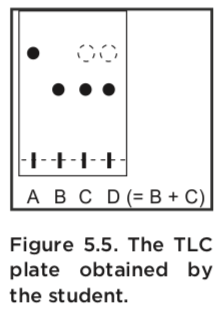5.4: TLC- IDENTIDAD Y PUREZA
- Page ID
- 70940
La TLC puede ser un recurso muy útil para obtener datos rápidos y útiles sobre pureza e identidad. A diferencia del análisis del punto de fusión, donde las mediciones se pueden comparar con los valores de la literatura, los experimentos de TLC de control son esenciales para apoyar la presencia de com- libras de interés. La TLC tiene una ventaja sobre el análisis del punto de fusión, sin embargo, en que se puede aplicar tanto a líquidos como a sólidos.
los valores de la literatura, los experimentos de TLC de control son esenciales para apoyar la presencia de com- libras de interés. La TLC tiene una ventaja sobre el análisis del punto de fusión, sin embargo, en que se puede aplicar tanto a líquidos como a sólidos.
Digamos que un estudiante bromó acetofenona usando bromo (esquema 1). Debido a que el producto contiene un enlace C-Br, la espectroscopia IR no es muy útil (el pico assosicado con un C-Br se encuentra en una región del espectro que es difícil de observar). En cambio, el estudiante realizó un análisis TLC.
Para obtener datos concluyentes del análisis TLC, el estudiante conformó una placa TLC con cuatro muestras. La mancha A es el material de partida acetofenona, la mancha B es una solución madre del producto, la mancha C es el producto obtenido por el estudiante y la mancha D es una comancha de dos soluciones, la solución madre del producto (mancha B) y el producto del estudiante (mancha C).
El análisis TLC nos da información importante sobre el experimento. El primer resultado es la muestra del estudiante, C, que parece ser dos compuestos. Una de esas (la mancha más oscura) concuerda con el producto auténtico (B), pero la otra (la mancha más clara) concuerda con el material de partida (A). Esto sugiere que el producto del estudiante está contaminado con material de partida sin reaccionar. El punto D respalda esta interpretación: las muestras B y C producen una única mancha oscura en D.


